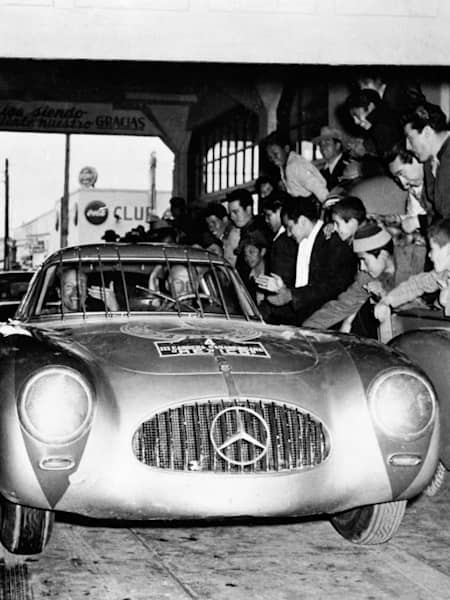No matter what World Rally Championship competitors have to face each year Rally Mexico, they can be sure that, no matter how hard the rally gets, it won’t be as gruelling as a different type of Mexican rally that took place between 1950-1954: the Carrera Panamericana.
The Carrera Panamericana was conceived as a road race by the Mexican government to showcase the opening of the Mexican stretch of the Panamerican Highway. Competitors in 1950 raced from Juarez in the north of the country down to Chiapas, on the border with Guatemala in the south – a distance of 2,096 miles, compared to the 250-odd competitive miles the WRC drivers face each year.
Professional drivers start competing at the Carrera Panamericana
While that first race in 1950 was an amateur affair, drivers from around the world, hungry for adventure and a government-backed payday soon got wind of the race and began to head on down to Mexico. By 1954, drivers like Juan Manuel Fangio, Carroll Shelby and Phil Hill had all competed in the race, with average speeds at the event soon moving north of the 100mph mark despite the course including twisty mountain road sections.
Fangio, who had grown up racing in similar cross-country slogs in his native Argentina, remains the only Formula One world champion to claim victory in the Carrera Panamericana, winning the 1953 race behind the wheel of a Lancia D24.
Danger lurks at ever corner
In 1952, Mercedes sent a three-car team of 300SLs to Mexico to try and claim the Carrera Panamericana win against rivals like Ferrari and Lancia.
Team driver Karl Kling won the race, followed home by fellow Mercedes driver Hermann Lang. But it was the accident that Kling suffered during that year’s Carrera Panamericana that became part of motor racing legend. Taking a fast right-hander, a vulture smashed headlong into Kling’s windshield, with the glass cutting the face of co-driver Hans Klenk. The pair carried on regardless and still managed to take the win by half an hour.
Others weren’t so lucky. A total of 27 competitors would die in the five years the event ran, a startling amount even at a time when motor racing was notoriously dangerous. The danger didn't deter the crowds however; it's estimated that between 1950-1954, some two million people lined the Panamerican Highway to watch the racers fly by.
It was actually the 1955 Le Mans disaster which made the Mexican authorities sit up and realise the danger of the Carrera Panamericana, and the organisers duly cancelled the race.
The legacy of the Carrera Panamericana
Against the odds, the race did make a comeback in 1988 and has been running as a historic event ever since, with notable recent winners including rally drivers Stig Blomqvist and Harry Rovanperä.
Elsewhere, the name 'Carrera' – Spanish for ‘race’ – has come to be synonymous with two brands steeped in motorsport history: Porsche and Tag Heuer, whose former boss Jack Heuer registered the ‘Carrera’ name for his company’s famous watch after learning about the race in the early 1960s.
Tragic and exhilarating in equal measure, the Carrera Panamericana has become part of motorsport folklore. Maybe the great Juan Manuel Fangio was thinking about the race when he uttered one of his most famous quotes:
There are those who keep out of mischief, and there are the adventurers. We racing drivers are adventurers; the more difficult something is, the greater the attraction that comes from it.
And races didn’t come much more difficult than the Carrera Panamericana…



